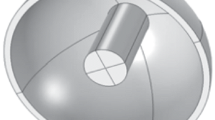The results of studying the effect of filamentary striae with birefringence 3 to 15 nm/cm in sitall [glass-ceramic] SO-115M on the quality of manufacturing of optical components of ring lasers and the accuracy characteristics of laser gyroscopes based on them are presented. It is shown that the presence of streaks with stresses not exceeding 15 nm/cm in sitall SO-115M does not affect the manufacturing accuracy of the resonator optical circuit and its assembly quality. The streaks in the output mirror of a ring laser serve as a source of additional backscattering and can increase the lock-in zone width. Proper adjustment of the output mirror makes it possible to reduce the amount of scattering and minimize the growth of the lock-in zone in a laser gyroscope. It is shown that the accuracy of a laser gyroscope is determined by the quality of the mirror substrates, the body geometry, and the level of backscattering inside the resonator.










Similar content being viewed by others
References
V. F. Shabanov and V. F. Pavlov, “Optically transparent glass ceramics with a low thermal expansion coefficient,” Glass Ceram., 61(1 – 2), 13 – 15 (2004).
E. Yu. Krekhova, S. V. Koshkin, and D. A. Khramogin, “Production of glass-ceramic materials at LZOS JSC: yesterday, to- day, tomorrow,” Nauch.-Tekh. Zh. Kontenant, 16(3), 53 – 57 (2017).
O. V. Savvova, L. L. Bragina, D. V. Petrov, et al., “Technological aspects of the production of optically transparent glass ceramic materials based on lithium-silicate glasses,” Glass Ceram., 75(3 – 4), 127 – 132 (2018).
F. Aronowitz, “Optical gyros and their applications,” RTO AGARDograph, 339, 3.1 (1999).
D. Lukyanov, Yu. Filatov, Yu. Golyaev, et al., “50th anniversary of the laser gyro,” in: 20th Saint Petersburg International Conference on Integrated Navigation Systems, ICINS 2013, Proceedings (2013), pp. 36 – 49.
M. N. Vittorio Passaro, Antonello Cuccovillo, Lorenzo Vaiani, et al., “Gyroscope technology and applications: A review in the industrial perspective,” Sensors, 17(10), 2284 (2017). URL: https://doi.org/10.3390/s17102284
K. N. Chopra, “Ring laser gyroscopes,” in: Optoelectronic Gyroscopes. Progress in Optical Science and Photonics. Vol. 11, Springer, Singapore (2021). URL: https://doi.org/10.1007/978-981-15-8380-3 1
A. O. Sinelnikov, A. A. Medvedev, Yu. D. Golyaev, et al., “Role of thermal drift of zero in magneto optica Zeeman laser gyroscopes,” Giroskopiya i Navigatsiya, 29[4(115)], 46 – 55 (2021). URL: 10.17285_0869-7035.0079
I. N. Khokhlov and A. O. Sinelnikov, “A method for measuring the lock-in zone in laser gyro sensors,” in: 28th St. Petersburg International Conference on Integrated Navigation Systems (ICINS) (2021).https://doi.org/10.23919/icins43216.2021.9470854
I. Savelyev and A. Sinel’nikov, “The influence of the pumping current on the Zeeman laser rotation sensors output parameters,” in: 22nd St. Petersburg International Conference on Integrated Navigation Systems, ICINS 2015. Proceedings (2015), pp. 421 – 424.
Yu. D. Golyaev, N. R. Zapotylko, A. A. Nedzvetskaya, et al., “Thermally stable optical resonators for Zeeman laser gyroscopes,” Opt. Spektrosk., 113(2), 253 – 255 (2012).
Y. A. Zubarev, A. O. Sinelnikov, and N. E. Fetisova, “Study of the temperature stability of the Zeeman laser gyro ring resonator,” in: 29th St. Petersburg International Conference on Integrated Navigation Systems (ICINS) (2022).https://doi.org/10.23919/ICINS51784.2022.9815336
L. A. Gubanova, Yu. A. Konstantinova, Optical Technologies, Textbook [in Russian], ITMO University, St. Petersburg (2018).
“Striae in optical glass. Shott. technical information,” in: Optics for Devices (2006). URL: https://wp.optics.arizona.edu/optomech/wp-content/uploads/sites/53/2016/10/tie-25striaeinopticalglassus.pdf
V. N. Sigaev, A. S. Lipatiev, S. S. Fedotov, et al., “Polarization-dependent birefringence in lithium aluminosilicate glass,” Glass Ceram., 79(1 – 2), 45 – 47 (2022).
J. M. Trujillo-Sevilla, M. Velasco-Ocaña, S. Bonaque-González, et al. “Wavefront phase measurement of striae in optical glass,” Appl. Optics, 61(14), 3912 – 3918 (2022).
A. A. Katkov, N. R. Zapotylko, and V. V. Fokin, “Method of leveling the influence of the inhomogeneity of a material of the output mirror of a laser gyroscope on the output signal,” Fiz. Obraz. v Vuzakh, 25(2S), 313 – 315 (2019).
Yu. D. Filatov, V. I. Sidorko, S. V. Kovalev, et al. “Effect of the rheological properties of a dispersed system on the polishing indicators of optical glass and glass ceramics,” J. Superhard Mater., 43, 65 – 73 (2021). URL: https://doi.org/10.3103/S1063457621010032
A. A. Wereszczak, A. T. Mayville, M. K. Ferber, and B. L. Hackett, Glass Striae and Laser Shock Damage, Oak Ridge National Laboratory (2018), 14 p. URL: https://info.ornl.gov/sites/publications/Files/Pub112277.pdf
N. V. Tikhmenev, S. A. Zakurnaev, A. V. Ozarenko, et al., “Influence of surface treatment and cleaning methods of glass-ceramic CO-115M on the strength of optical contact,” Sci. Tech. Bull. of Inform. Technol., Mechanics and Optics, 16(4), 613 – 619 (2016).
V. V. Azarova, Yu. D. Golyaev, and I. I. Saveliev, “Zeeman laser gyroscopes,” Quantum Electronics, 45(2), 171 – 179 (2015).
A. N. Vinogradov, N. R. Zapotyl’ko, A. A. Katkov, et al., “Problems of optical contact when connecting elements of helium-neon lasers,” Opt. Zh., 81(4), 61 – 67 (2014).
T. O. Lipatieva, S. I. Stopkin, A. S. Lipatiev, et al. “Optimization of the formations parameters of hollow channels in glass by direct laser writing and selective etching,” Glass Ceram., 79(7 – 8), 249 – 252 (2022).
A. V. Balykov, Diamond Drilling of Holes in Parts Made from Brittle Non-Metallic Materials [in Russian], Nauka i Tekhnologiya, Moscow (2003).
Author information
Authors and Affiliations
Corresponding author
Additional information
Translated from Steklo i Keramika, No. 5, pp. 3 – 13, May, 2023.
Rights and permissions
Springer Nature or its licensor (e.g. a society or other partner) holds exclusive rights to this article under a publishing agreement with the author(s) or other rightsholder(s); author self-archiving of the accepted manuscript version of this article is solely governed by the terms of such publishing agreement and applicable law.
About this article
Cite this article
Sinelnikov, A.O., Zapotylko, N.R., Zubarev, Y.A. et al. Aspects of Sitall SO-115M Use in the Fabrication of the Optical Components of He–Ne Ring Lasers. Glass Ceram 80, 171–177 (2023). https://doi.org/10.1007/s10717-023-00579-5
Received:
Published:
Issue Date:
DOI: https://doi.org/10.1007/s10717-023-00579-5



